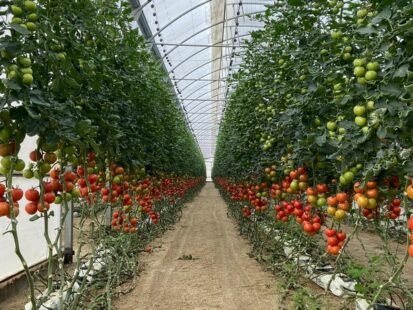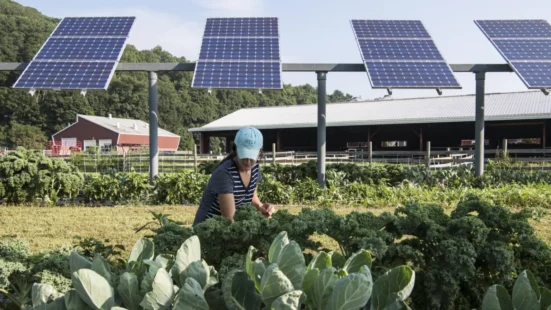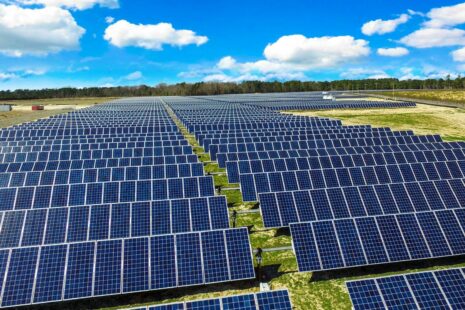
Inside Tatura’s brand-new, multimillion-dollar glasshouse, the winter jackets are off. 28 degrees Celsius and the aroma of 150,000 tomato truss plants permeate the air. 60 new jobs will be created at the site and 4,000 tonnes of tomatoes will be produced annually by the new six-hectare glasshouse. According to Mike Nichol, chief executive of Flavorrite, the company will grow across its four Victorian locations due to the increasing demand for vegetables. He continued, “We have one here in Tatura, one in Katunga, one in Mansfield, and our home base in Warragul. “Currently, Warragul is the largest, but there is space for an additional 30 acres near Katunga. “In Tatura, we have space for three more of these glasshouses and a sizable packing facility that will enable us to ship goods.”
Year-round tomato, cucumber, and pepper cultivation is done by the company. According to Mr. Nichols, recent floods in northern Australia has brought to light the benefits of indoor gardening. During those kinds of situations, “all of those crops are at risk of deterioration,” he said. “With the help of this infrastructure, we can guarantee that won’t occur to us. The product on the vine will definitely be delivered, we promise.” The Business Growth Fund and Regional Jobs Fund of the Victorian government have both invested in the company. The $250 million fund was created by Spirit Super and Aware Super and is administered by investment management company ROC Partners.
Tim Pallas, the Victorian Treasurer, stated that “we’re effectively transforming cash to an asset for the state, whether it’s a loan or an equity share.” “Despite having 3% of the country’s total land area, Victoria today produces more agricultural goods than Queensland. “It demonstrates that we are the breadbasket of the country, and the only way we can maintain that reputation is by expanding methods of effectively delivering agriculture.” Protected cropping is a developing sector in Australia as more farmers find it challenging to plant outdoors due to floods and bushfires. Chris Millis, Flavorite’s operations officer, claims that glasshouses have numerous benefits despite being expensive to install.
Mr. Millis stated, “We can generate more with less.” “We don’t need to travel about, the product benefits from year-round labour, and less water, chemicals, and inputs are used in its production. “It’s unquestionably the way of the future, in my opinion. “Field farming is our primary rival, but it’s not as easy to be a farmer outside when you consider bushfires and floods,” said the expert. Natural gas is burned with a hydronic heating system to heat the Tatura glasshouse. Heating is our biggest expense, according to Mr. Millis. “The goal of everything we do is to use as little heat as possible. “We have two rows of thermal screens in the roof that move across at night to trap heat, and we strive to do our best to do as much as we can with the sun.
In terms of water usage, we need 12 to 18 litres to produce 1 kilogramme, but in the field, it’s more like 60 to 100 litres. “We absorb and reuse runoff when it occurs.” Countries like the Netherlands, who made significant investments in the technology to enable year-round growth, have been at the forefront of the glasshouse produce industry. According to Mr. Millis, the technology has been modified to work in Victoria’s climate, but the global market for it is expanding. She said, “The Dutch are creative; their glasshouses are built for cold weather.” “We have modified technology to accommodate a cold winter and a warm summer, and countries like Canada, France, the United States, Mexico, and Russia have done the same. Everywhere, glasshouses are being constructed.

The first commercial-scale solar-powered and carbon-neutral farm in Australia could be on the horizon. However, instead of large farm fields, it’ll be placed within city buildings. Eden Towers, based in Western Australia, has announced intentions to build four 12-meter-high growth tower platforms for a precision-controlled indoor habitat where plants can thrive without soil all year. The […]
Read More →
Chris Brayley began his career as an electrician, repairing air conditioning and refrigeration. His company, Brayley Electrical, has adjusted its focus in recent years to become more focused on solar power, especially as even more consumers on farms and ranches turn away from generators as diesel prices continue to increase. Mr. Brayley claims that his […]
Read More →
As the number of solar farms in Australia grows, so does the controversy over heavy metals in solar panels and the difficulty of recycling them. Lynette LaBlack, a farmer in the Riverina region of southern New South Wales, has been questioning everyone who will listen with uncomfortable questions. She questioned Metka EGN regarding its solar […]
Read More →